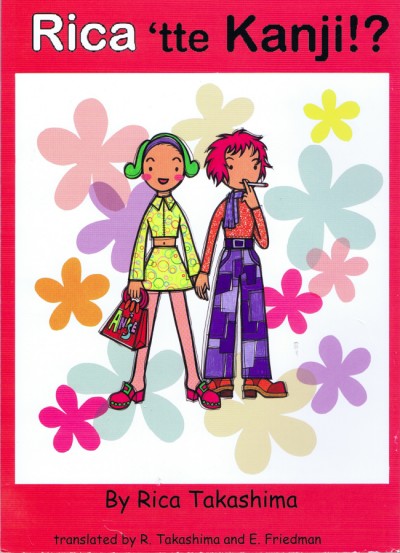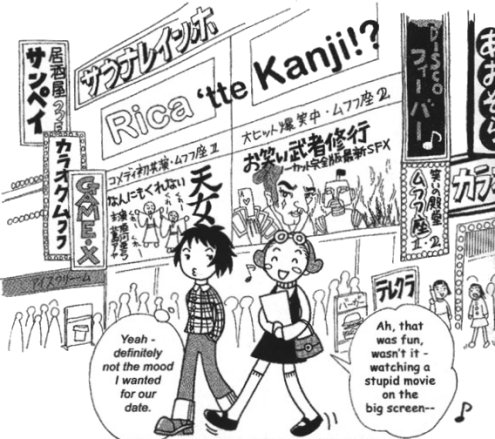The most basic yuri plotline — what publisher Erica Friedman calls “Story A” — traces its roots back to the pioneering Class S fiction of Nobuko Yoshiya (1896-1973). In works such as Hana monogatari (1916-24) and Yaneura no nishojo (1919), schoolgirls developed intense, often romantic, feelings for other schoolgirls. Given the period in which Yoshiya wrote, it’s not surprising that her characters’ relationships were never consummated; the girls might exchange passionate letters or meaningful glances, but marriage, graduation, or death prevented them from being together as a couple. Fifty years later, when manga artists such as Ryoko Yamagishi and Riyoko Ikeda began writing girls’ love stories, they, too, favored tragic endings; Yamagishi’s Shiroi Heya no Futari (1971), for example, culminates in a melodramatic death (suicide by ex-boyfriend, to be exact), as do Ikeda’s Oniisama e… (1975) and Claudine…! (1978).
Small wonder, then, that manga-ka Rica Takashima saw a vacuum that needed filling. “There were very few manga with lesbian stories,” Takashima explains in the afterword to Rica ‘tte Kanji!? “Only depressing, sad stories about ‘forbidden love’ and with a break-up in the end. For example, ‘If I were a man, I could marry you.’ That kind of thing, but I wanted to read a HAPPY story.”
And “happy” is the perfect adjective to describe Rica ‘tte Kanji!? Rica, the heroine, is a cheerful optimist who moves to Tokyo to attend junior college (she plans to major in early childhood development) and explore the Nichome district, home to the city’s gay community. At the beginning of the series, Rica is nervous about visiting Nichome for the first time, worrying about what to wear and how to handle pick-up lines:
Rica’s fears are quickly allayed when she’s introduced to Miho, a sardonic art student a few years Rica’s senior. The two meet cute on Rica’s first trip to Nichome’s Lily Bar, where Rica confesses that she’s never met “an actual lesbian.” “I grew up out in the country,” she explains to Miho. “It’s the same for everyone in the beginning,” Miho assures her, prompting Rica to declare Miho her first gay friend. Though Miho falls for Rica right away, Rica’s lack of experience and general ditziness makes her oblivious to Miho’s advances. Their relationship has another hurdle to clear as well: Rica is just as nervous about the idea of having sex as she was about making a good impression at the Lily Bar, and keeps Miho at arm’s length — figuratively and literally — as she tries to decide what she’s comfortable doing.
What Takashima does better than most is to find the comedy in these situations, not by creating artificial misunderstandings between the characters, or manufacturing romantic rivals, but by making us privy to Rica and Miho’s thoughts. The two women’s internal monologues are funny, peppered with cute and weird observations, but they’re also very truthful; who among us hasn’t worried about putting the moves on a friend or being naked with a new partner?
Though Takashima’s script is charming, what really makes Rica ‘tte Kanji!? work is the art. That may seem like a funny thing to say about a story in which the characters are little more than well-dressed stick figures with cute, round faces, but Takashima’s illustrations have a warm, handmade quality. Better still, the artwork never panders to male yuri fans; by rendering the characters as cute, paper-doll figures, Takashima directs the eye away from Rica and Miho’s bodies towards their faces, compelling the reader to see the women as two people fumbling through a relationship, not fantasy objects.
And speaking of fantasy, a few reviewers have pointed out the absence of real conflict in Rica ‘tte Kanji!?. Though Miho and Rica’s relationship hits a few minor snags, their romance takes place in a bubble untouched by homophobia or workaday concerns. It’s a fair criticism, I suppose, but one that misses the point; Rica ‘tte Kanji!? is a cheeky, cheerful rebuke to the Tragic Gay Story, substituting a happily-ever-after ending for death and separation.
Impatient readers can find copies of Rica ‘tte Kanji on Amazon for about $24.00. If you’re willing to wait a few months, however, ALC Publishing will be releasing a new omnibus edition that will include the original Rica ‘tte Kanji stories, as well as material written for ALC’s Yuri Monogatari anthologies.
RICA ‘TTE KANJI!? • BY RICA TAKASHIMA • ALC PUBLISHING • 96 pp.




Erica says:
Kate – thanks so very much for the review!
Katherine Dacey says:
You’re very welcome! I’ve been meaning to post this since MoCCA, but hadn’t figured out what I would say about it besides, “Hey, Rica ‘tte Kanji is awesome!” Your articles at The Hooded Utilitarian were very helpful in clarifying my thoughts. Looking forward to your next one!
Erica says:
We’re hard at work on it. ^_^
Ian S says:
“If you’re willing to wait a few months, however, ALC Publishing will be releasing a new omnibus edition that will include the original Rica ‘tte Kanji stories, as well as material written for ALC’s Yuri Monogatari anthologies.”
On paper or as an e-book? I’d be very happy to pay for the former but wouldn’t really have any interest in the latter, no matter how low the price.
The reason I ask is that I seem to remember Erica saying somewhere (Anime News Network?) that she didn’t see print as being financially viable for ALC.
Katherine Dacey says:
I’m not sure if there’s a print edition in the works, Ian. If you’re on Twitter, you could ask Erica directly; her Twitter handle is @Yuricon. I’ll also make some inquiries and will update the entry to reflect what I find out.
Ian S says:
Sadly, my Luddite soul is even less receptive to the idea of Twitter than it is to the concept of reading books on my computer.
Logan says:
Personally I’ve always preferred happy (or at least contented) yuri to that with a tragic end, and it interests me to see any english yuri that exists for more than just titillation, so I’m anxious to try this out when the omnibus releases. I’ve never understood why so much english yaoi exists when there’s so little yuri; why can’t I see titles like Cotton, Octave, Strawberry Sweet Shake, or Girlfriends get released in the states..? Alas, I’m getting off topic — this was a great writeup!
Katherine Dacey says:
Good question! I’m kind of surprised no one has licensed Maria-sama ga Miteru; from my totally unscientific survey of anime blogs and forums, it seems like there might be a market for the original novels or the manga adaptation here in the US. I guess Seven Seas’ brief but not-very-successful foray into yuri scared off other mainstream publishers.
Erica says:
The truth is that the market for Yuri is much smaller than the audience for Yuri. At the moment, there is not enough of a critical mass in the *buying* audience to make licensing Yuri a net-positive effort. And Light Novels have hella translation costs as compared with manga. In the case of Maria-sama ga Miteru, the company (Shueisha) told Tokyopop flat out that they would not let them be licensed here in the US. I won’t conjecture why.
Ian – Both if all goes well. At ALC Publishing we are absolutely committed to bringing our books to as many people who want to read them as possible, and we’re going to do what we can to change the world and make it easier, rather than harder.
At this point, the whole thing is still in process – I can’t give an ETA, but I’ll keep folks apprised on Yuricon and Okazu.
Cheers,
Erica
Hungry for Yuri? Have some Okazu: http://okazu.blogspot.com
Yuricon – “For real women who like their woman…animated”
http://www,yuricon.com
Jade Harris says:
I haven’t read this, but you really expressed well what I liked about Takashima’s stories in Yuri Monogatari. It wasn’t a constant stream of angst or what the straight mainstream wants to see, it was fun stories about people being alive rather than being entertaining or educational.
I also have to agree with your answer to questions of the story’s lack of conflict. In that first page you posted, I see plenty of conflict to the story’s actual theme, a fantasy story about personal growth. Fitting with the fantasy theme, the situations and settings are more an extension of the Rica’s personal journey and struggles whereas the conflict of other genres are more externally-driven. Or maybe I’m wrong and Sarah Silverman needs to talk about Israel and the Holocaust more often. That’s the sort of conflict Jewish stories are about, right?
Katherine Dacey says:
That’s a good point; most of the conflict is within the character, which can make the story seem less eventful. But for me, that’s what makes Rica work. I find her interior monologues very funny and real. (I loved the fact that she made a point of wearing new underwear for her first visit to the Nichome District — that totally cracked me up.)
And yes, it’s nice to see a range of responses to the question of gay identity; everyone’s journey is different, and when there’s only one narrative, it loses its impact with repetition.
Romanticide says:
I have that manga and… I didn’t find it that interesting… it has great moments, it is cute and I really understand that a fluffy storie was urgently needed at the time but Rica it just ain’t that good. Maybe it is the amateurish art, maybe is the lack of actual story (which I doubt given that are other mangas like Plica who managed to succed with the same too factors) I don’t really know.
Katherine Dacey says:
I could see how some folks might find it too uneventful to be dramatically persuasive. I happened to find its naivete charming, but I can understand that for some readers the amateurishness of the storytelling and the art might be a drawback, rather than a strength, of the work.
Thanks for your comment!
Tegan says:
I realize that I’m very late to the party on this review, but I just thought I’d chime in with this:
Although Rica ‘Tte Kanji is one of my favourite comics and possibly my favourite media with LGBT themes, it’s always bugged me that Kaoru’s situation is kind of played for laughs. I’m transsexual myself and the idea of not being considered a “real” lesbian for it is an unfortunately common prejudice. I would have appreciated it if there were even some implication that Kaoru were still in Rica’s group of friends before the end of the book.
Katherine Dacey says:
I admit that I didn’t pay much attention to Kaoru’s situation when I read Rica ‘tte Kanji, but I just pulled out my copy and see your point: her identity is presented as being less “real” or “authentic” as the other characters who patronize the Lily Bar. Thanks for pointing that out!
Tegan says:
Thanks. 🙂 It’s been a while since I’ve been on here. Personally I’d really like to see something as positive for transsexualism as Rica is for lesbianism, since it’s otherwise my go-to story to cheer me up.